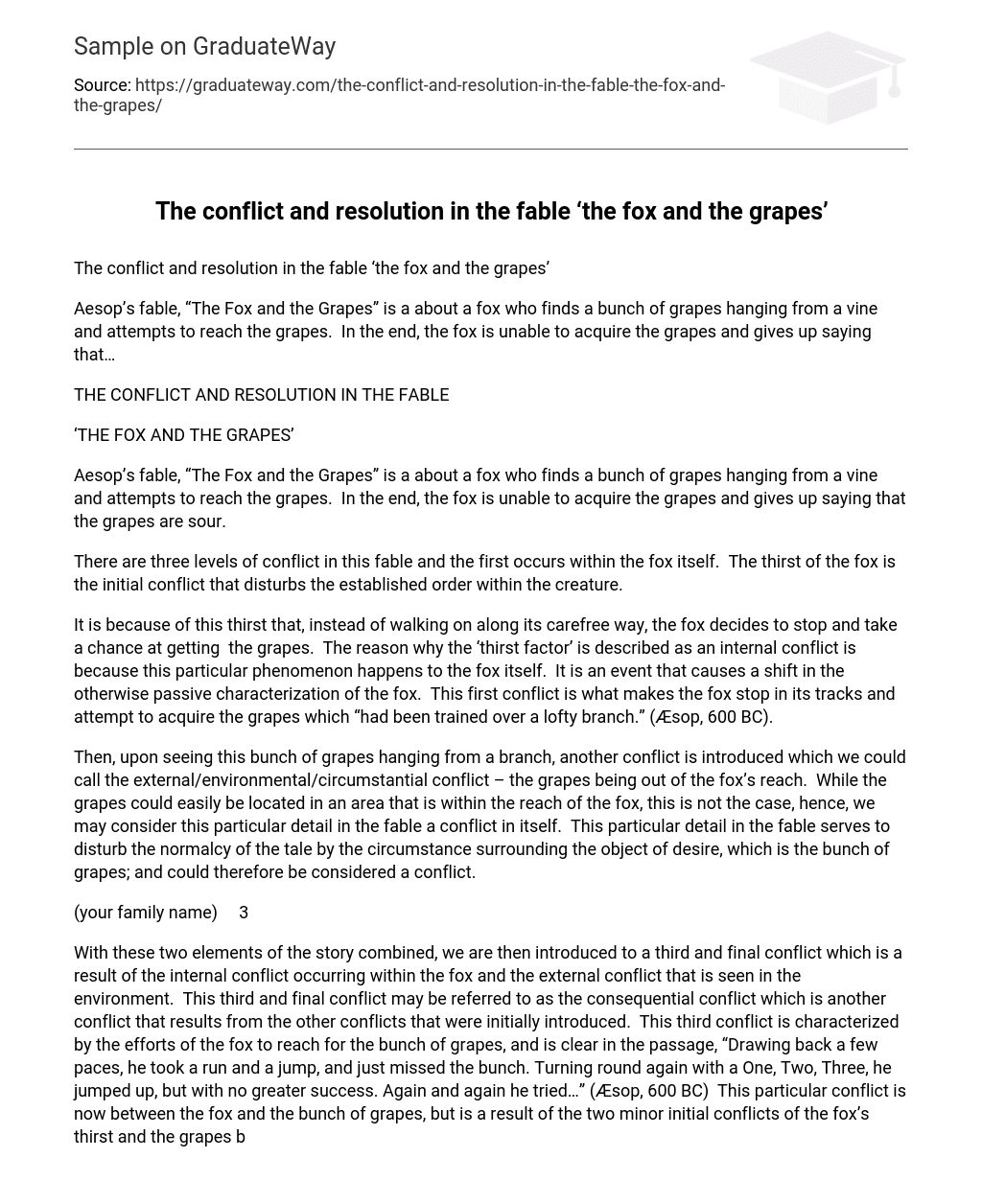Aesop’s fable, “The Fox and the Grapes” is a about a fox who finds a bunch of grapes hanging from a vine and attempts to reach the grapes. In the end, the fox is unable to acquire the grapes and gives up saying that the grapes are sour.
There are three levels of conflict in this fable and the first occurs within the fox itself. The thirst of the fox is the initial conflict that disturbs the established order within the creature.
It is because of this thirst that, instead of walking on along its carefree way, the fox decides to stop and take a chance at getting the grapes. The reason why the ‘thirst factor’ is described as an internal conflict is because this particular phenomenon happens to the fox itself. It is an event that causes a shift in the otherwise passive characterization of the fox. This first conflict is what makes the fox stop in its tracks and attempt to acquire the grapes which “had been trained over a lofty branch.” (Æsop, 600 BC).
Then, upon seeing this bunch of grapes hanging from a branch, another conflict is introduced which we could call the external/environmental/circumstantial conflict – the grapes being out of the fox’s reach. While the grapes could easily be located in an area that is within the reach of the fox, this is not the case, hence, we may consider this particular detail in the fable a conflict in itself. This particular detail in the fable serves to disturb the normalcy of the tale by the circumstance surrounding the object of desire, which is the bunch of grapes; and could therefore be considered a conflict.
With these two elements of the story combined, we are then introduced to a third and final conflict which is a result of the internal conflict occurring within the fox and the external conflict that is seen in the environment. This third and final conflict may be referred to as the consequential conflict which is another conflict that results from the other conflicts that were initially introduced. This third conflict is characterized by the efforts of the fox to reach for the bunch of grapes, and is clear in the passage, “Drawing back a few paces, he took a run and a jump, and just missed the bunch. Turning round again with a One, Two, Three, he jumped up, but with no greater success. Again and again he tried…” (Æsop, 600 BC) This particular conflict is now between the fox and the bunch of grapes, but is a result of the two minor initial conflicts of the fox’s thirst and the grapes being located beyond the fox’s reach. Conflicts in stories can be seen in various elements of the tale, as is with any other tale. Sometimes the conflict can only be in the major character, the circumstances surrounding a particular event, the setting, or a combination of all of these.
Finally, in the end, the fox “at last had to give it up, and walked away with his nose in the air” (Æsop, 600 BC). This now is the story’s resolution. The resolution of the story is referred to as the consequential result of all the events that took place in the story. This usually follows the ‘cause and effect’ principle; hence, the thirst of the fox made him attempt to acquire a bunch of grapes that were beyond his reach; all these elements led to one thing – the fox’s giving up its attempt to acquire the grapes and walk away saying that the “grapes are sour”. (Æsop, 600 BC). The story resolution is therefore the final action of the fox, which is to stop yearning for the grapes and just simply dismiss the item and walk away. The story is thus resolved.
Works Cited
Æsop. Fables, retold by Joseph Jacobs. Vol. XVII, Part 1. The Harvard Classics. New York: P.F.
Collier & Son, 1909–14; Bartleby.com, 2001. www.bartleby.com/17/1/. [Date of
Printout].





